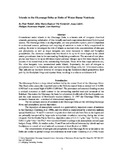Islands in the Okavango delta as sinks of water-borne nutrients

View/
Date
2005Author
Wolski, P.
Murry-Hudson, M.
Fernkvist, P.
Liden, A.
Huntsman-Mapila, P.
Ramberg, L.
Publisher
Botswana SocietyType
Published ArticleMetadata
Show full item recordAbstract
Groundwater under islands in the Okavango Delta is a known sink of inorganic dissolved minerals, preventing salinisation of this virtually enclosed evaporation-dominated hydrological system. The Okavango Delta is an oligotrophic, yet very productive system, and it is important to understand sources, pathways and recycling of nutrients in order to fully comprehend its ecology. In order to investigate the role of islands as nutrient sinks, concentrations of nitrogen and phosphorus, as well as major inorganic ions were measured in island and floodplain groundwater. The electrical conductivity was found to be up to 50 times higher in the island centre groundwater than in the surrounding floodplain groundwater. The amount of total phosphorus was found to be up to 400 times higher and total nitrogen up to five times higher in the interior of the island than in the surrounding floodplain. These show that major nutrients are, like other inorganic ions, accumulated under islands. Importantly, the ratio of nitrogen to phosphorus was 5:1 in floodplain water and water in island fringe soils, but 1:4 in island centres. his indicates an intensive removal of nitrogen along the floodplain-island groundwater flow path by the floodplain fringe and riparian biota, resulting in a relative enrichment in P.
Collections
- Research articles (ORI) [270]
